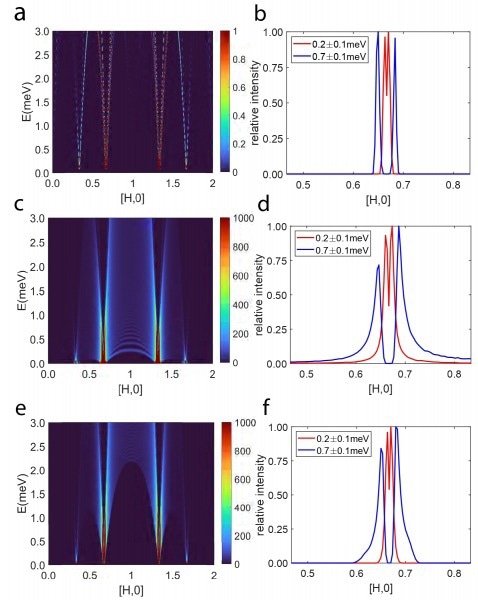Reviewed by Lexie CornerMay 14 2024
Theoretical physicists from various international institutions provided insight into the long-expected development of quasiparticles, which are similar to the well-known Dirac particles that obey the relativistic Dirac equation. The research recently published in Nature Physics proposed that these quasiparticles, also called Dirac spinons, reside in a brand-new quantum state known as a quantum spin liquid state.
 Linear spin wave prediction on the kagome lattice: a and b show the spin spectra without introducing disorder effects. c and d display the spectra with the same parameters but introduce disordered effects to fit the experimental results. e and f show the spectra with different kinds of disorder. Image Credit: The University of Hong Kong
Linear spin wave prediction on the kagome lattice: a and b show the spin spectra without introducing disorder effects. c and d display the spectra with the same parameters but introduce disordered effects to fit the experimental results. e and f show the spectra with different kinds of disorder. Image Credit: The University of Hong Kong
Dr. Chengkang Zhou and Professor Zi Yang Meng from The University of Hong Kong, experimentalists Zhenyuan Zeng and Professor Shiliang Li from the Institute of Physics (IOP), Chinese Academy of Sciences (CAS), and Professor Kenji Nakajima from J-PARC Center, Japan, collaborated for the research.
Quasiparticles are fascinating objects that arise from the collective behavior of materials; they can be thought of as a collection of particles. In particular, the Dirac spinons are predicted to have unique properties like a linear dispersion relation between energy and momentum, resembling the Dirac electrons in graphene and quantum moire materials and Dirac particles in high-energy physics.
However, prior to this work, such spin-neutral, charge-neutral quasiparticles were not observed in quantum magnets.
To find Dirac spinons in quantum magnets has been the dream of generations of condensed matter physicists; now that we have seen the evidence of them, one can start to think about the countless potential applications of such highly entangled quantum material. Who knows, maybe one day people will build quantum computers with it, just as people have been doing in the past half-century with silicon.
Zi Yang Meng, Professor and Study Corresponding Author, The University of Hong Kong
The elusive quasiparticles were observed in YCu3-Br, a unique material with a kagome lattice structure. This substance was the focus of the team's work. Previous research had suggested that the material would display a quantum spin liquid state, which made it a prime target for investigation.
To facilitate the detection of spinons in YCu3-Br, the research team surmounted various obstacles by aggregating around 5000 individual single crystals. This assembly satisfied the criteria necessary for conducting experiments like inelastic neutron scattering.
The group investigated the material's spin excitations using sophisticated methods, such as inelastic neutron scattering. They found interesting conical spin continuous patterns that resembled the distinctive Dirac cone.
Due to experimental constraints, it was difficult to directly detect a single spinon; nevertheless, by comparing the team's results with theoretical expectations, they were able to identify specific spectrum signatures indicative of the presence of spinons in the material.
It has always been difficult to find spectrum evidence of Dirac spinon excitations. It can be compared to a clear cry cutting through the fog of spectral inquiry on the quantum spin liquid state, as this result offers strong evidence for the existence of a Dirac quantum spin liquid state. The results pave the way for future research into the characteristics and uses of YCu3-Br while advancing the basic understanding of condensed matter physics.
The quantum spin liquid state, characterized by the existence of fractional spinon excitations, may have implications for quantum information and high-temperature superconductivity. The spins are strongly intertwined in this condition and stay disordered at low temperatures.
Examining the spectral signals from spinons obeying the Dirac equation would result in a deeper comprehension of the quantum spin liquid state of matter. This knowledge also acts as a road map for its more general applications, such as the investigation of quantum information and high-temperature superconductivity.
The research was funded by the Ministry of Science and Technology of China, the Chinese Academy of Sciences, and grants from the Hong Kong Research Grants Council. Neutron scattering measurements were performed on AMATERAS, J-PARC.
Journal Reference:
Zeng, Z., et al. (2024) Spectral evidence for Dirac spinons in a kagome lattice antiferromagnet. Nature Physics. doi.org/10.1038/s41567-024-02495-z.